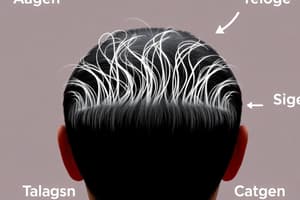Podcast
Questions and Answers
What is the primary focus of the content provided?
What is the primary focus of the content provided?
- Types of skin layers
- Structure of hair follicles
- Hair color variations
- Growth cycle of hair (correct)
How many phases are there in the hair growth cycle?
How many phases are there in the hair growth cycle?
- Three (correct)
- Five
- Four
- Two
What is a potential focus of hair examination mentioned?
What is a potential focus of hair examination mentioned?
- Texture assessment
- Color testing
- Type of hair examination (correct)
- Density analysis
Which layer of the skin is mentioned in relation to hair?
Which layer of the skin is mentioned in relation to hair?
What aspect of hair growth is indicated to have phases?
What aspect of hair growth is indicated to have phases?
What is the typical time frame mentioned for noticeable changes or growth of hair?
What is the typical time frame mentioned for noticeable changes or growth of hair?
What condition of hair follicles is indicated in the content?
What condition of hair follicles is indicated in the content?
Which method is mentioned for masking the color of hair?
Which method is mentioned for masking the color of hair?
What can be inferred about an individual who shows no hair growth?
What can be inferred about an individual who shows no hair growth?
In forensic examinations, which aspect of hair is likely to be questioned?
In forensic examinations, which aspect of hair is likely to be questioned?
Flashcards are hidden until you start studying
Study Notes
Hair Growth Cycle
- There are three phases of hair growth.
- The first phase is the anagen phase, which is the active growth phase.
- The second phase is the catagen phase, which is the transitional phase.
- The third phase is the telogen phase, which is the resting phase.
Hair Examination
- Hair examination can reveal the type of hair that is present at a crime scene.
- It can be used to determine if hair is natural or artificial, human or animal.
- The number of sample hairs collected from the scene is noted.
Hair Dyeing
- The color of hair can be masked with artificial dyes.
- Dark hair can be lightened with hydrogen peroxide.
Hair Contamination
- Hair can be contaminated with foreign materials like mucus, blood, fecal matter, and semen.
- This contamination can help to identify the location of hair at a crime scene.
Differentiating Between Natural and Artificial Hair
- Natural hair can be distinguished from artificial hair by examining its structure.
- Natural hair has a cuticle, cortex, and medulla, while artificial hair does not.
Human vs. Animal Hair
- Human and animal hair can be differentiated by examining their morphological features.
- These features include the scale pattern, medulla shape, and the presence or absence of a cuticle.
Studying That Suits You
Use AI to generate personalized quizzes and flashcards to suit your learning preferences.





